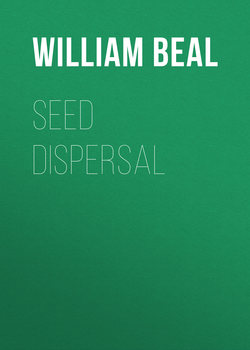Seed Dispersal

Реклама. ООО «ЛитРес», ИНН: 7719571260.
Оглавление
Beal William James. Seed Dispersal
CHAPTER I. HOW ANIMALS GET ABOUT
CHAPTER II. PLANTS SPREAD BY MEANS OF ROOTS
CHAPTER III. PLANTS MULTIPLY BY MEANS OF STEMS
CHAPTER IV. WATER TRANSPORTATION OF PLANTS
CHAPTER V. SEEDS TRANSPORTED BY WIND
CHAPTER VI. PLANTS THAT SHOOT OFF THEIR SPORES OR SEEDS
CHAPTER VII. PLANTS THAT ARE CARRIED BY ANIMALS
CHAPTER VIII. MAN DISPERSES SEEDS AND PLANTS
CHAPTER IX. SOME REASONS FOR PLANT MIGRATION
BIBLIOGRAPHY
Отрывок из книги
1. Most of the larger animals move about freely. —When danger threatens, the rabbit bounds away in long jumps, seeking protection in a hollow tree, a log, or a hole in the ground. When food becomes scarce, squirrels quickly shift to new regions. Coons, bears, skunks, and porcupines move from one neighborhood to another. When the thickets disappear and hunters abound, wild turkeys and partridges retreat on foot or by wing. When the leaves fall and the cold winds blow, wild geese leave the lakes in secluded northern homes, and with their families, reared during the summer, go south to spend the winter. Turtles swim from pond to pond or crawl from the water to the sand bank, where they lay and cover their eggs. Fishes swim up or down the creek with changing seasons, or seek deep or shallow water as their needs require. Beetles and butterflies, when young, crawl about for food and shelter, and when older use their wings in going long distances.
These examples only serve to recall to mind what every boy or girl knows and has known ever since he can remember – that most animals move about whenever they want to, or whenever other animals will let them.
.....
Roots have a peculiarity not usually known. They stretch out and crook about here and there, penetrating the crevices of the soil wherever there is the least chance, and the matured portions begin to shorten, reminding one somewhat of an angleworm when one end has been stepped on. By this shortening process the top or crown of a dandelion or plantain is pulled down beneath the surface of the ground.
4. How nature plants lilies. —Lilies grow from bulbs which are planted six inches beneath the surface. Do you know how nature plants them? A seed starts and becomes a small plant on the surface of the leaf mould or a little beneath; little roots push downward and to right and left; and later, after getting a good hold below with numerous branchlets, the slender roots shorten and tug away at the tiny bulb above, as much as to say, "Come down a little into mother earth, for cold winter is approaching and there will be danger from frost." The young bulb is drawn down an inch more or less, the slender roots perish with the growing year, but the bulb is preserved. The seedling was well planned; for while it had yet tender leaves during its first year, starch and protoplasm were stored up in the thickened scales of the bulb. During the second spring some of this food in store is used to send down another set of slender roots with the message to gather in more water, potash, phosphorus, nitrogen, and other substances to help grow a larger bulb. In late summer and autumn the new roots contract and pull away at the greater bulb, and down it goes into the ground another inch or so. I have a theory as to how it finally comes to be drawn down just deep enough and no more, but I will not venture to give it. This process is repeated from year to year till the proper depth is reached for preserving the full-grown bulb. And this is the way nature plants bulbs.
.....